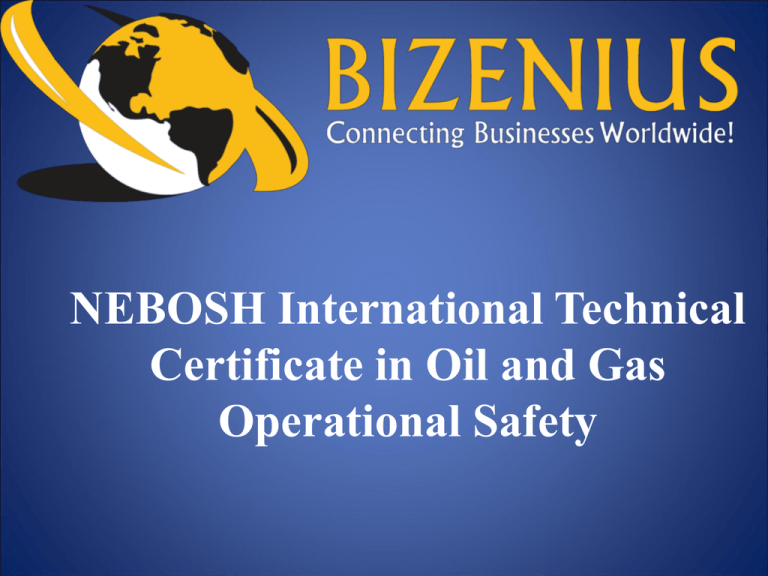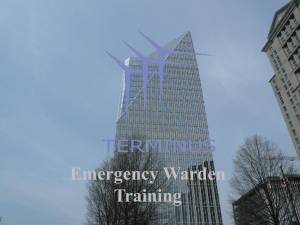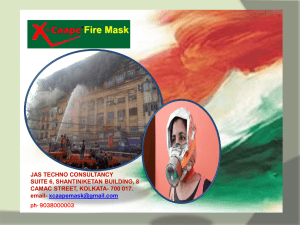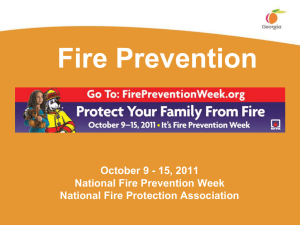BIZENIUS-IOG1-Element-4-Fire
advertisement

NEBOSH International Technical Certificate in Oil and Gas Operational Safety 4 Fire protection and emergency response Learning outcomes 4.1 Outline appropriate control measures to minimise the effects of fire and explosion in the oil and gas industries 4.2 Outline the principles, procedures and resources for effective emergency response Content Fire and explosion risk in the oil and gas industries 4.2 Emergency response 4.1 Leak and fire detection systems • Fire and gas detection systems in Oil and Gas installations are designed to mitigate unexpected events • Designers need to know what is available in order to choose the correct systems for their plants • There are two principal types of detector which are commonly in use in off-shore installations: 1) Heat, flame and smoke 2) Flammable gas instruments Gas detection Infrared absorption combustible gas detection • The technology uses the absorption characteristics of the hydrocarbon molecules to infra-red light • This technology is more expensive than catalytic detection • It is used for many applications • Point infra red detectors record the gas concentration at the detector location • They need to be placed where a release of gas is considered possible Gas detection Infrared absorption combustible gas detection • Infrared open-path gas detectors send out a beam of infrared light, detecting gas anywhere along the path of the beam • This linear ‘sensor’ is typically a few metres up to a few hundred metres in length • An open path detector usually costs more than a single point detector • The open path detector excels in outdoor situations Gas detection Infrared point gas detector Source: J.Hind. Gas detection Catalytic gas detectors • Catalytic detectors rely upon burning gas in a sintered chamber • For this reason they are only available as a point detector or as part of a multi-point aspirating system Source: J.Hind. Gas detection Toxic gas detection • Technologies available include chemical cell and semiconductor point detectors • Many different types of gas can be detected Source: J.Hind. Leak detection • Leak detection may not be considered to be part of the fire and gas detection system • Leak detection is often regarded as a supervisory or maintenance facility, or an adjunct to the fire and gas system by using them in conjunction with other detection methods Leak detection Ultrasonic leak detectors • Devices are available for detecting the sound of leaks at ultrasonic frequencies • Mainly used for outdoor environments where weather conditions can easily dissipate Source: J.Hind. Fire detection Infrared (IR) flame detectors • The detector relies on infrared radiation produced by flames Ultra-violet (UV) flame detectors • These detectors rely on the effective detection of ultra-violet radiation produced by flames Smoke detection Point smoke detectors • Detect smoke at a fixed point • They need to be placed where smoke realistically could travel in the event of a fire Source: J.Hind. Smoke detection Ionisation point smoke detectors • These detectors use a small radioactive source and detect decreased conduction caused by the ionisation of smoke particles in a detection chamber Optical point smoke detectors • These detectors generally detect smoke particles inside a chamber by an increase of light scatter caused by smoke particles or by the smoke particles obscuring a light beam Heat detection • Heat detection is used where ambient temperatures or environment preclude the use of smoke detection Source: J.Hind. Heat detection Point heat detection • These detect high temperatures at a given point • They are still commonly described as “Rate of rise, and fixed heat detectors” • Example uses include: kitchens, turbine hoods Linear (line) heat detectors • These detectors detect heat somewhere along the length of the device • Example uses include: tank rim seals; cable tunnels Passive fire protection Types of PFP • Spray coatings • Enclosures • Fireproof cladding • Seals and sealants • Cable coating • Fire walls • Compartmentalisation Active fire protection • Active fire protection systems such as water sprinkler and spray systems are widely used in the process industries for protection of storage vessels and process plant • The duty of the fire protection system may be to extinguish the fire, control the fire, or provide exposure protection to prevent domino effects • Systems can be fixed (for example, deluge or sprinkler systems) or portable (extinguishers) Choice of fire fighting media Types of fire fighting media are: • Water • Foams • Inert gases • Chemical powders • Halons Choice of fire fighting media Fixed water based systems • A source of water: sea water, tank, river, wells • A pump: designed to deliver at the required flow rate and pressure, with quick or automatic activation • Fire water mains: a piping system to transport the water from the pump to where it is needed (for example, fire hydrants, risers, sprinkler heads) • Water systems primarily operate by cooling the fire • Water is suitable for use in environments containing solid combustible materials (class A fires) Choice of fire fighting media Fixed foam systems • Similar to fixed water based systems, except that a foam concentrate is injected into the fire water system from a separate vessel • Foam is a stable mass of small, air-filled bubbles that have a lower density than oil, petrol, or water • Foam can be used on fire involving solid combustible materials and is highly effective on flammable liquid fires (for example: hydrocarbon fuel fires) Choice of fire fighting media Fire monitor converted for foam use Source: Williams Fire & Hazard Control Choice of fire fighting media Foam monitor: may be used to protect tanks or jetties Source: Narfoam Kar Company. Choice of fire fighting media Sprinkler systems • The purpose of an automatic sprinkler system is to detect the fire, extinguish or control the fire and to raise the alarm • Each sprinkler head will open when it reaches a specific temperature and spray water on to a fire Source: J.Hind. Choice of fire fighting media Deluge systems • Deluge water spray systems are similar to sprinkler systems, except all nozzles are open and will discharge together when the system is activated Source: J.Hind. Choice of fire fighting media Water mist systems • Water mist is a fine spray with 99 percent of water volume contained in water droplets less than one millimetre (1,000 microns) in diameter Source: J.Hind. Choice of fire fighting media Dry powder installations (chemical) • Dry powders, in common with vaporising liquids, offer the advantage of a quick knock-down of fire, but unlike vaporising liquids, they have negligible toxic effects • A dry powder installation consists of dry powder containers linked by pipework to discharge nozzles covering the areas of risk Choice of fire fighting media Gaseous (inerting) extinguishing systems • Traditional flood systems, such as those using carbon dioxide • Where the displacement of air within the enclosure is necessary for their successful operation may be considered to be inerting systems • Inerting system works by smothering the fire, and thus excluding the air/oxygen Examples of specific fire protection systems Floating roof tanks • Floating roof tanks have a roof which rises and falls with the liquid level inside the tank • Thereby decreasing the vapour space above the liquid level • They are used for the storage of crude and volatile products Source: Indiamart. Examples of specific fire protection systems Fixed roof tanks • Foam injection or water cooling systems can be used • Foam injection may be either from fixed injectors situated either above the liquid surface, sub - surface, or from foam monitors operated remotely Source: Narfoam Kar Company. Examples of specific fire protection systems Spheres • Water deluge systems, either manually or automatically activated, are used for vessel cooling in order to help prevent vessel failure • The vessel may be protected from radiant heat by burying or, if above ground, by applying passive fire protection (such as sprayed coatings) to the vessel and its supports to mitigate the effects of fire Examples of specific fire protection systems Offshore process modules • Deluge and sprinkler systems are used in areas where hydrocarbon pool fires are likely to occur • Deluge systems tend to provide a wider level of protection • Water deluge also has the advantage of being able to provide general area protection to personnel and open escape routes Content Fire and explosion risk in the oil and gas industries 4.2 Emergency response 4.1 Introduction • Emergency planning and response is part of an overall strategy for preventing and minimising the effects of major accidents to people, plant and the environment • There are three basic steps involved: - Identification - Prevention and control - Mitigation Emergency response plan (ERP) Role and importance • A well prepared, and rehearsed, ERP can significantly reduce the consequences of a major accident; a written ERP: - Allocates roles and responsibilities - Outlines the actions to be taken for all likely emergencies - Provides the basis for communicating to all parties involved or affected - Demonstrates emergency preparedness compliance to regulatory authorities Content of an emergency response plan • Control and command structure • Foreseeable emergency situations • Arrangements for limiting the risk to personnel • Training of staff • Off site assistance • Alarm systems Medical emergency planning Tiered response • • The MER is divided into tiers or levels The following scheme is recommended by the Oil and Gas Producers Association (OGP): Level 1 Basic first aid Level 2 Advanced first aid Level 3 Trained paramedic or emergency medical technician Level 4 Doctor or nurse working in a primary care facility Level 5 Specialist doctor working in a secondary or tertiary care facility Medical emergency planning Medical evacuation procedures and back up resources • Medical evacuation is the timely and efficient movement and en route care provided by medical personnel to injured personnel being evacuated from the scene of an accident, and who require urgent care at better equipped facilities • Factors to consider include: risks to the patient; type of emergency; resources required • Evacuation may be by land (ambulance), sea or air (helicopter or air ambulance) Principles of escape, evacuation and rescue Escape • Effectiveness of escape routes include: - Numbers and locations of workers - Width of routes - Free from obstruction - Travel distances - Considerations for disabled workers - Protection against effects of fire and explosion - Adequate signage and lighting - Provision of temporary refuge Principles of escape, evacuation and rescue Evacuation • A means of escape from the installation is required so that persons may evacuate in the event of the failure of the primary evacuation system (air or sea) in a catastrophic incident, when a planned and orderly evacuation cannot be achieved • Evacuation from an offshore installation: - A means of descent to sea level - Something which offers some protection from the elements and avoids the need to enter the sea directly Principles of escape, evacuation and rescue Lifeboat in cavite/Free fall lifeboat/Free fall lifeboat interior Source: Safety first. Principles of escape, evacuation and rescue Skyscape - entering the next cell/next person get ready Source: Safety first. Principles of escape, evacuation and rescue Recovery and rescue • Effective arrangements need to be in place, to enable persons who have to evacuate or to escape from the installation to be recovered or rescued to a place of safety • Recovery will also be required: - To rescue persons from the sea near the installation - In the event of a helicopter ditching into the sea during landing or take off Roles and structure of emergency response teams Onshore installations • Emergency control centre (ECC) • Site main controller • Site incident controller Roles and structure of emergency response teams Offshore installations • The person in overall charge of an emergency is the Offshore Installation Manager (OIM) • Specific considerations offshore will include: - Contact with external services - Communication with inter-connected installations - Alerting rescue and recovery services - Contact with onshore liaison personnel - Alerting personnel engaged in installation activities Roles and structure of emergency response teams Training and drills • All personnel should be instructed as to the actions to be taken in the event of an emergency, in particular: - Alarm actions - Location of escape and evacuation routes - Muster/assembly points - The use/operation of any emergency equipment Learning outcomes 4.1 Outline appropriate control measures to minimise the effects of fire and explosion in the oil and gas industries 4.2 Outline the principles, procedures and resources for effective emergency response 4 Fire protection and emergency response






